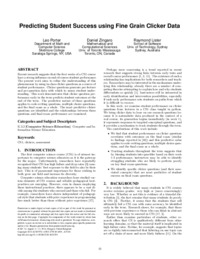Predicting student success using fine grain clicker data Publikationsdatum:
Zu finden in: ICER 2014 (Seite 51 bis 58), 2014
|
 |
 Diese Seite wurde seit 3 Jahren inhaltlich nicht mehr aktualisiert.
Unter Umständen ist sie nicht mehr aktuell.
Diese Seite wurde seit 3 Jahren inhaltlich nicht mehr aktualisiert.
Unter Umständen ist sie nicht mehr aktuell.
 Zusammenfassungen
Zusammenfassungen
Recent research suggests that the first weeks of a CS1 course have a strong influence on end-of-course student performance. The present work aims to refine the understanding of this phenomenon by using in-class clicker questions as a source of student performance. Clicker questions generate per-lecture and per-question data with which to assess student understanding. This work demonstrates that clicker question performance early in the term predicts student outcomes at the end of the term. The predictive nature of these questions applies to code-writing questions, multiple choice questions, and the final exam as a whole. The most predictive clicker questions are identified and the relationships between these questions and final exam performance are examined.
 Dieses Konferenz-Paper erwähnt ...
Dieses Konferenz-Paper erwähnt ...
 Begriffe KB IB clear | rainfall problem |
 Zitationsgraph
Zitationsgraph
 Zitationsgraph (Beta-Test mit vis.js)
Zitationsgraph (Beta-Test mit vis.js)
 2 Erwähnungen
2 Erwähnungen 
- Koli Calling 2015 - Proceedings of the 15th Koli Calling Conference on Computing Education Research, Koli, Finland, November 19-22, 2015 (Päivi Kinnunen, Judy Sheard) (2015)
- Do we know how difficult the rainfall problem is? (Otto Seppälä, Petri Ihantola, Essi Isohanni, Juha Sorva, Arto Vihavainen) (2015)


- Do we know how difficult the rainfall problem is? (Otto Seppälä, Petri Ihantola, Essi Isohanni, Juha Sorva, Arto Vihavainen) (2015)
- ICER 2020 - International Computing Education Research Conference, Virtual Event, New Zealand, August 10-12, 2020 (Anthony V. Robins, Adon Moskal, Amy J. Ko, Renée McCauley) (2020)
- A Longitudinal Evaluation of a Best Practices CS1 (Adrian Salguero, Julian J. McAuley, Beth Simon, Leo Porter 0001) (2020)


- A Longitudinal Evaluation of a Best Practices CS1 (Adrian Salguero, Julian J. McAuley, Beth Simon, Leo Porter 0001) (2020)
 Anderswo finden
Anderswo finden
 Volltext dieses Dokuments
Volltext dieses Dokuments
 |  Predicting student success using fine grain clicker data: Fulltext at the ACM Digital Library ( Predicting student success using fine grain clicker data: Fulltext at the ACM Digital Library ( : :  , 1175 kByte; , 1175 kByte;  : :  2020-11-28) 2020-11-28) |
 Anderswo suchen
Anderswo suchen 
 Beat und dieses Konferenz-Paper
Beat und dieses Konferenz-Paper
Beat hat Dieses Konferenz-Paper während seiner Zeit am Institut für Medien und Schule (IMS) ins Biblionetz aufgenommen. Beat besitzt kein physisches, aber ein digitales Exemplar. Eine digitale Version ist auf dem Internet verfügbar (s.o.). Aufgrund der wenigen Einträge im Biblionetz scheint er es nicht wirklich gelesen zu haben. Es gibt bisher auch nur wenige Objekte im Biblionetz, die dieses Werk zitieren.










 Biblionetz-History
Biblionetz-History